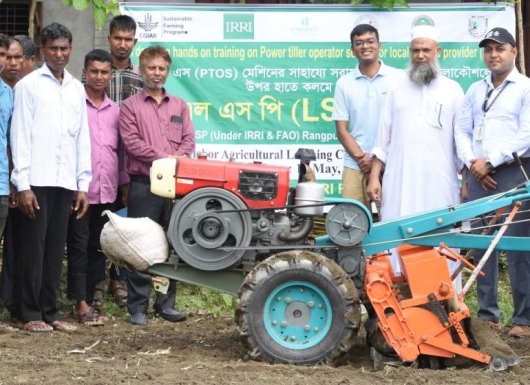Submitter: International Rice Research Institute - IRRI
Mechanized Direct Seeded Rice (DSR) is an alternative crop establishment method to conventional puddled transplanted rice (PTR). In this approach, either dry paddy seeds are sown directly into dry soil using a tractor-mounted seed drill (dry-DSR), or pre-germinated seeds are sown into a puddled field (wet-DSR). Dry-DSR offers several advantages: it conserves water, reduces labor requirements, lowers greenhouse gas (GHG) emissions and production costs, and enhances soil structure by eliminating the need for puddling. When integrated with best management practices—such as Integrated Weed Management (IWM) and Integrated Nutrient Management (INM)—DSR can lead to improved productivity, increased profitability, and long-term sustainability in rice cultivation.

A key prerequisite for DSR is laser land leveling, which ensures uniform seed emergence and enhances both water and nutrient use efficiency. Dry-DSR reduces the cost of cultivation by eliminating the need for nursery preparation and manual transplanting. Additionally, it significantly lowers water and labor requirements and shortens the crop duration by 8 to 15 days, depending on the variety. This earlier harvest enables timely sowing of succeeding crops such as wheat, pulses, or oilseeds, allowing better utilization of residual soil moisture. As a result, dry-DSR contributes to increased cropping intensity and system productivity.
DSR is best suited to medium-textured soils with assured irrigation and low weed pressure. It performs well in areas where pre-sowing irrigation is available and in regions traditionally practicing broadcasting or beushening. However, DSR is unsuitable for areas with poor drainage, very heavy or very light textured soils, or saline conditions. Promising regions for DSR adoption include broadcasted or beushening areas in eastern India and the rice–wheat cropping systems of Punjab and Haryana. Rice hybrids tend to perform particularly well under DSR due to their early vigor and effective weed suppression
Comparative research on mechanized DSR over PTR in Odisha has demonstrated increase in yields by over 1 t/ha compared to traditional broadcasted rice. Additionally, mechanized DSR can boost profitability by more than USD 350 per hectare, primarily due to reduced cultivation costs and higher yields. Dry-DSR also contributes to 30–50% lower GHG emissions and facilitates the early sowing of short-duration pulses and oilseeds in rice-fallow areas, enabling more effective utilization of residual soil moisture and enhancing cropping system productivity.
Mechanized DSR holds significant potential for scaling, as it addresses critical challenges related to labor shortages, water scarcity, greenhouse gas emissions, and long-term sustainability. However, effective scaling requires several enabling conditions: the development and availability of DSR-suitable rice varieties, spatial suitability mapping, and reliable access to tractors and seed drills. Additionally, assured irrigation during sowing and availability of pre-emergence herbicides are essential for effective weed control, as weed pressure remains a major constraint in DSR systems. For smallholder farmers, who often cannot afford their own machinery, promoting a service provision model for seed drills is crucial to ensure equitable access and widespread adoption.
Dr. Peramaiyan Panneerselvam, Scientist II - Cropping Systems Agronomy
Email: p.panneerselvam@cgiar.org,
Phone: 917358255641